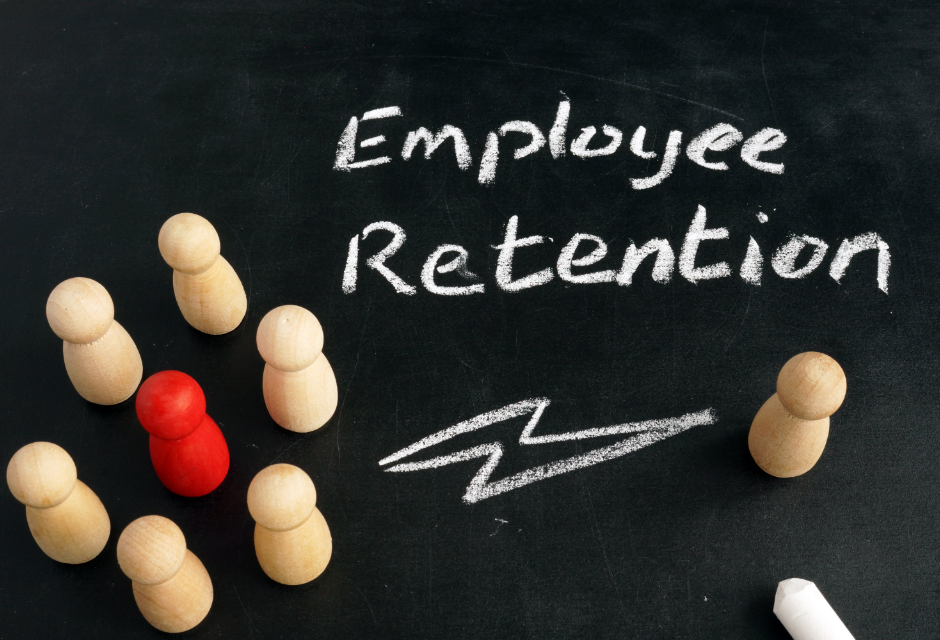Businesses may retain their best employees and maintain productivity by strategically implementing new employee retention strategies. Workflow can be severely disrupted by the loss of even one employee, and it might take some time for the remaining staff to get things back on track.
The extra expense of hiring and training a new employee is frequently greater than the additional expenses of keeping an experienced employee on staff.
Although specific strategies can be implemented with the intention of enhancing employee satisfaction. It's also advisable to keep in mind that long-term worker retention requires a comprehensive approach and may involve benefits offerings, HR insights, analytics, top-notch hiring, and providing career advancement opportunities.
Even though it's hard to keep every employee, there are a variety of creative employee retention tactics that can assist your company in reducing turnover, encouraging employee engagement, and creating a desirable workplace.
We'll learn everything about employee retention and subjects that are relevant in today's guide. Let's look at what this comprehensive guide will cover next:
Understanding Employee Retention
Significance of Employee Retention
Calculating Employee Retention Rate
How does your employee experience (EX) plan account for employee retention?
Advantages of Employee Retention
Employee Retention Vs. Employee Turnover: Differences
What Factors Contribute to Employee Turnover?
Employee Retention Mistakes that Employers Must Avoid
Key Strategies of Employee Retention and Best Practices
Best Examples of Employee Retention
Let’s Start!
Understanding Employee Retention
Employee retention refers to a company's capacity to maintain (retain) its current workforce over a prolonged period of time. It is directly related to employee experience because increased Intent to Stay is linked to positive experiences.
In simple words, the employees are frequently only considered "retained" if they are happy, productive, motivated, content, and not looking for other work.
Employer retention strategies, which are frequently employed to boost employee engagement and provide attractive incentives, can help organizations avoid having excessive amount of turnover.
Keep in mind that employees stay with your organization longer if your retention rate is higher. Your retention rate will decrease the more often you hire and fire people for the same position.
Significance of Employee Retention
Turnover costs for American enterprises totals $1 trillion annually. Businesses should prioritize staff retention above all else for a trillion and a trillion reasons.
In addition, there are certain expenses to consider when staff departs from a company, such as:
- Cost and time involved in finding a replacement (including recruitment and onboarding of new talent)
- decreased productivity throughout the hiring and onboarding process,
- lower morale among the remaining employees
- lost business and skill knowledge
Actually, Gallup's research found that replacing an employee might cost anywhere between 50% and 100% of their annual salary. Beyond lower hiring and training costs, companies who keep their employees for extended periods of time benefit in other ways.
Eventually, your company's culture, productivity, and competitiveness are all influenced by how well you can keep your staff.
Without the right talent, your company won't be able to grow or achieve its objectives. If the right staff aren't already present, your company won't be able to hire the extra workers it will need.
Moreover, if the right people aren't there, your company could lose the distinctive cultural charm that makes it stand out from the competitors. Positive effects on an organization's business line and culture can be seen when there is high staff retention.
Understanding your employee retention rate is crucial for the following three reasons:
Your Workforce is More Efficient and Productive
People who not only understand their roles but also can operate well in a team are advantageous to companies that can keep their personnel.
Moreover, these people frequently progress to become powerful organizational leaders. They not only follow the regulations to the letter, but they can also train others, which makes the hiring and employee onboarding process simpler.
Reduces Costs
Getting new hires can be expensive. Each employee represents a sizable time and training investment, even after they have entered the building.
Furthermore, companies benefit from better commitment, skill, and morale from people who are content in their work. Employers who endure high turnover miss out on the advantages of employee talent and work experience.
Enhances Corporate Culture
Being in a workplace where you constantly worry about getting fired is incredibly unsettling. And while employing fresh talent might be thrilling, it can also leave you with the impression that you don't know anyone at all.
Moreover, high retention fosters teamwork. Employee morale is raised, and production increases. Less time is spent on processing new and departing personnel.
Calculating Employee Retention Rate
Understanding what exactly employee retention rate entails is necessary before we can calculate it.
The employee retention rate is the proportion of workers who are stuck with a company over a specific time frame.
By routinely monitoring the employee retention rate, an organization may keep track of its workforce, establish whether employee counts are going up or down, and spot any barriers to employee growth. Using this information, a company can enhance its onboarding procedures and staff retention strategy.
Choosing the time period for which a business wishes to measure the proportion of retained employees is the first step in calculating the employee retention rate.
Following that decision, businesses utilize a straightforward formula to determine their staff retention rate during the chosen time period.
You may calculate your company's total retention rate for a specific time period using a straightforward equation (e.g. in a year).
This measure can be used to compare staff retention and rapidly see how it alters over time.
Any new employees employed within the predetermined period would not be counted against the organization's initial headcount.
Moreover, organizations frequently evaluate their talent retention rates on a quarterly, biannual, or annual basis. Between 70 and 90 percent is generally considered to be the average employee retention rate for firms.
Furthermore, staff retention rates are known to vary by industry, so businesses must keep an eye on how they stack up against those of their competitors.
How does your Employee Experience (EX) Plan Account for Employee Retention?
Retention and employee experience are closely tied. In fact, one of the five KPIs we take into account when assessing the quality of employee experience a company offers is Intent to Stay.
Broadly said, if the employee experience falls short of expectations, good people will go. Additionally, the likelihood that your employee experience is of a high caliber is high if individuals are showing a strong desire to stay for the long term.
Intent to Stay measurements of employee turnover are a component of a larger picture of Employee Experience (EX) management.
Although you can't directly influence Intent to Stay, you can improve the factors that contribute to it, such as follow-up and communication, work-life balance, growth and development, training, salary and perks, and the sense of authority and empowerment your workers have at work.
Advantages of Employee Retention
Keeping employees on board involves more than just reducing loss to the company when they depart. It also provides chances to raise a number of important indicators of performance for the organization.
We have further discussed benefits that firms receive from employing effective staff retention strategies and procedures.
Let's learn and check some of the crucial advantages or benefits of employee retention. Let’s check:
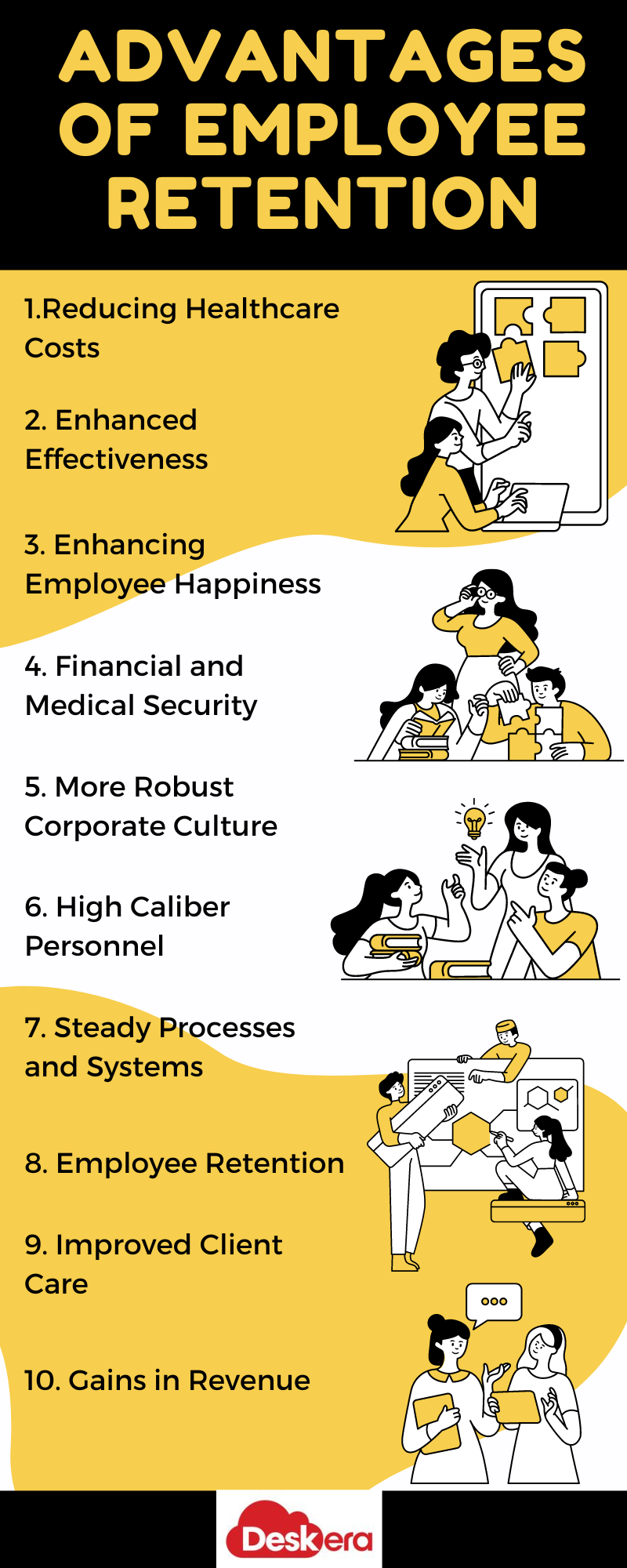
1. Reducing Healthcare Costs
Your company will ultimately benefit from investing in wellness programs now as part of employee benefits by saving time, money, and paperwork on continuing medical expenses.
In the long run, wellness programs can help save a significant amount of money on healthcare costs by helping to prevent long-term or chronic diseases, particularly lifestyle disorders like diabetes, obesity, etc.
2. Enhanced Effectiveness
Organizational effectiveness is increased by talent retention. When a high-performing employee leaves, replacing them can be difficult and time-consuming due to the continuous screening processes of interviews, onboarding, and onboarding programs.
In the meanwhile, understaffing can pose an array of issues for organizations. Functionality is disrupted by unwanted delays and communication problems.
Keeping people on board keeps initiatives moving forward steadily. Long-term employees are familiar with business procedures and have built relationships with their coworkers. As a result, strong teams are formed, thus boosting overall productivity.
3. Enhancing Employee Happiness
Long-term employees benefit from good working circumstances since they can serve as role models for younger employees.
When new hires learn about their accomplishments, they might take advantage of the chance to progress their careers there. Monitoring employee experience throughout an employee's career is not always challenging.
However, businesses that invest in digital technologies have an advantage since they can make decisions based on data.
4. Financial and Medical Security
If your workforce is not troubled by fear about prospective medical bills, they will perform considerably more productively.
You are sending a message to your staff that you are prepared to invest in their careers and well-being by providing them with comprehensive healthcare coverage.
5. More Robust Corporate Culture
Long-term employees typically have similar values and attitudes and are well-aligned with the organization they work for.
When you have a large number of employees who are a good fit for your company, they function well together.
More significantly, they help one another when they are in need. This enhances your workplace culture and draws in more like-minded individuals to your company.
6. High Caliber Personnel
The majority of the time, people improve at their jobs as a result of their continued employment with your company. They might also have held multiple positions, giving them a solid understanding of how various departments operate.
Employees with this background are in high demand because they can handle projects that call for departmental cooperation and can operate effortlessly across several teams.
7. Steady Processes and Systems
When a firm runs with a lovely rhythm and effective workflow, there is more time for creation.
Since they are aware of what works and what doesn't, long-tenured employees who are experts at managing day-to-day activities can help others avoid falling into the same trap they did.
Making sure incoming staff don't go in the wrong direction eliminates planning time and keeps your business moving.
8. Employee Retention
If advantages and perks are provided to employees, they will be more inclined to remain with your business.
Better benefits allow you to give your workers higher levels of job satisfaction. It will further keep them working for your business longer. Also, it will help you hire better and more talented workers.
9. Improved Client Care
Long-term employees tend to feel more connected to their company, which has a favorable impact on how they serve customers. They can also handle difficult situations with dexterity and ease that isn't as typical in fresher recruits because they have years of experience under their belts.
10. Gains in Revenue
After a specific number of years in a position, a person's knowledge and competence advance increasing their output and income.
Most long-term workers are content with their positions because they would leave if they weren't. They may make use of their established contacts to deliver exceptional customer service and financial returns because they are frequently more engaged than newer employees.
Employee Retention Vs. Employee Turnover: Differences
Differentiating between staff turnover and employee retention may be helpful. Retaining a certain group of employees, or your finest talent, on board is more important for retention than keeping an objective eye on workforce changes.
By tracking turnover, you can determine how much your staff is evolving and whether the new hires you make are expanding or merely maintaining it.
What Factors Contribute to Employee Turnover?
Respected professionals occasionally quit a company despite its best efforts for a number of reasons. Employee turnover pertains to both wanted and undesirable exits from your company.
Here, in this section, we'll focus on the reasons why workers leave when you'd prefer them to stay, i.e., the times when your employee retention efforts failed.
Why do workers leave their jobs?
- Misalignment with the values of an organization
- Priorities are now different
- Feeling unappreciated
- Feeling exhausted
Frequently, another employer will present a more alluring prospect. They might tempt your staff, for instance, with
- Improved manager-staff interactions
- Greater satisfaction at work
- More adaptable working conditions
- Better balancing of work and life
- Improved corporate culture, higher remuneration
- Less expensive health insurance
- Better chances for professional growth or career promotion
- Greater career clarity
Employee Retention Mistakes that Employers Must Avoid
The pitfalls that employers must avoid when it comes to employee retention are covered here. As we learn:
Concentrating primarily on financial gains
Not everything is about the pay or financial gains. It is important to look at deeper aspects as well.
According to our study, people who voluntarily quit their occupations indicated that they would do so again provided the following advantages were made available to them:
1) Greater flexibility with regard to working hours;
2) Shorter working hours, and;
3) More paid vacation days
Unreliable managers
It is crucial that managers have the tools and support they need to not only hear what their employees have to say but also to act on it. It will further help to improve employee engagement, their experiences and also increases employee satisfaction. Nearly all of the major factors that affect employee engagement are influenced by managers.
Failing to respond to employee feedback
According to our research, having a listening program really decreases engagement more than not having one at all. Employees are likely to believe that you are wasting their time if they believe that you are collecting their input but not using it.
Assuming preventing burnout and maintaining well-being is solely the employee's responsibility
In order to create a workplace and corporate culture that will keep people for a longer period of time, employers, managers, and employees all have a role to play.
Organizations can lessen employee burnout by establishing certain policies. These policies must support work-life balance, prioritizing health and repair, normalizing taking unplugged breaks, and setting an example for staff.
Discrimination against parents who work
According to a recent study, 45% of working parents experienced discrimination at work because they prioritized taking care of their families.
In order to retain top talent in today's cutthroat labor market, organizations must adjust to the changing realities - and expectations - of working parents for a better work experience.
Key Strategies of Employee Retention and Best Practices
You must act quickly to strengthen your staff retention methods. It must be done especially if you suspect that your company is in danger of losing outstanding personnel.
The following strategies that you must consider can help you raise employee job satisfaction and your capacity to retain valued staff members:
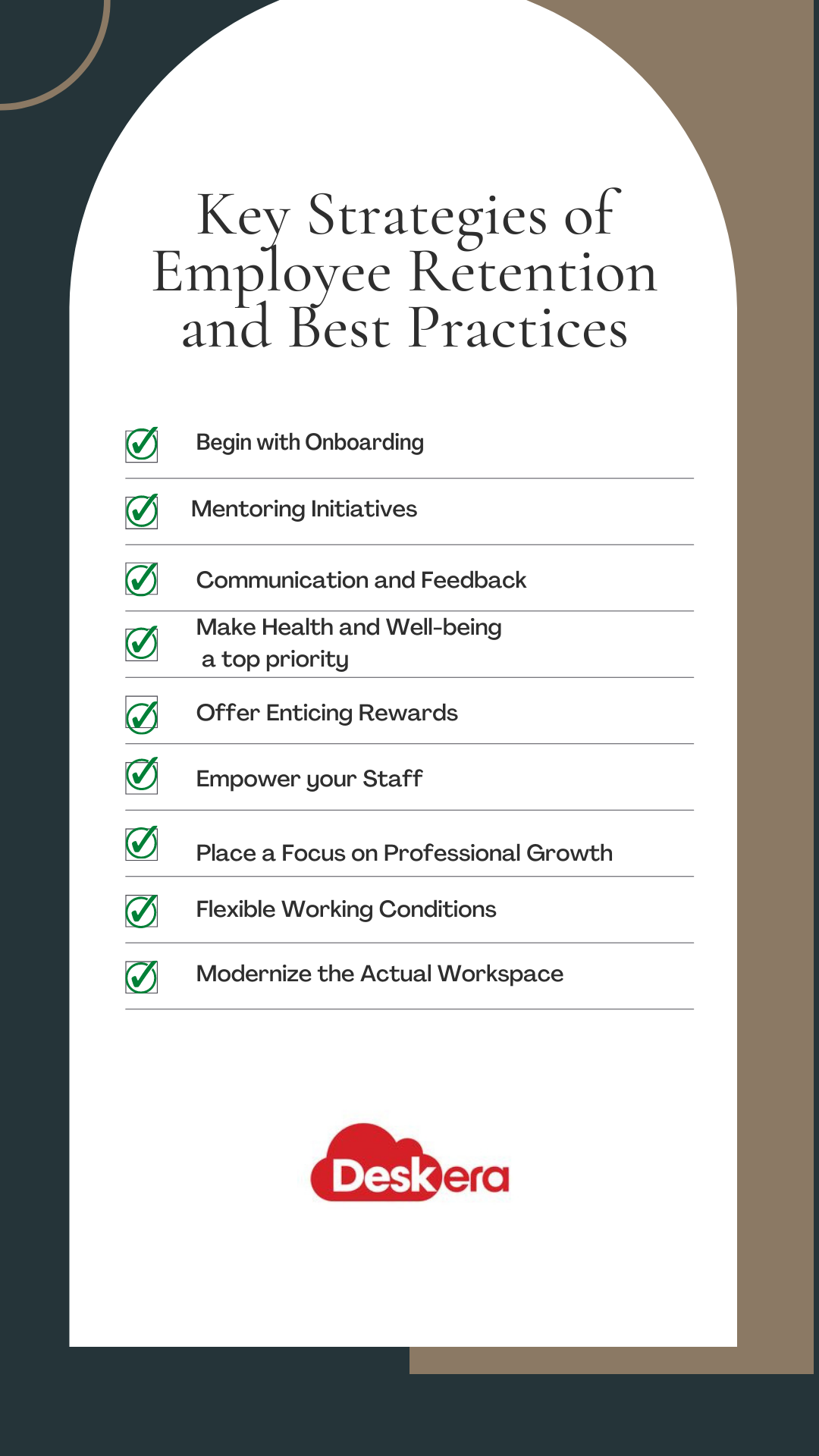
Begin with Onboarding
You must focus on retention from the first day itself.
A seamless onboarding procedure fosters a sense of belonging and increases employees' faith in the company. Furthermore, they will believe they are working with knowledgeable individuals who genuinely care about enabling them to succeed in their new position. They will be at ease enough to inquire and make an effort to learn.
Moreover, every new employee must be set up for success from the start. Your onboarding procedure should instruct new hires on the workplace culture and how they may contribute to and thrive in it in addition to the work.
Don't skimp on this crucial first step. Whether in person or online, the orientation you provide new hires can set the standard for their entire employment with your business.
Mentoring Initiatives
Pairing a new hire with a mentor is a great addition to your extended onboarding process, especially in a remote work environment.
Supervisors can welcome new team members, offer guidance, and act as a source of advice. And it benefits both parties because new team members get knowledge from seasoned workers while also providing their mentors with a different perspective.
However, don't just offer mentoring opportunities to new hires. Relationships between mentors and mentees can be quite beneficial for your current employees. It will also helps to enhance your team's job happiness and attitude on employee retention.
Communication and Feedback
Regular listening has a significant impact on both engagement and, consequently, retention. For instance, engagement increases to 61 percent when a company has a feedback program in place, compared to 45 percent when it does not.
It's critical to pay attention to both what's said and what isn't stated in any relationship. Moreover, teams function efficiently when there is open communication among members. It further encourages collaboration among coworkers, improves workplace efficiency, and resolves problems as they happen.

The problems that cause low retention and high turnover can be resolved (and prevented) in large part by devoting time to improving your communication abilities.
If you would like to know how things are doing at work, just ask. Make it as easy as you can for employees to give you feedback.
To show them that you respect them, pay attention to what they have to say. Put their suggestions into action when you can. This further encourages trust and a sense of ownership in the workplace.
Make Health and Well-being a top priority
Putting money into employee well-being can boost morale and reduce burnout. But it's also fantastic for the employer, in addition to the employee. Leaders have discovered that concentrating on personal well-being enables them to better look after themselves and manage their teams.

It's crucial to make multiple investments in your well-being. Although employee wellness programs are a useful addition to the office, breaks and vacations are still necessary.
Make sure your workforce is prepared to operate productively and comfortably from home. Set a good example by taking time off for your physical and emotional well-being.
Offer Enticing Rewards
Do some research to determine the competitive pay scale for your staff (and, if required, hiring a consultant). Make remuneration trustworthy and fair. Make sure employees are informed of every detail of their salary.
Stipends, stock options, incentives, and reimbursements fall under this category. Make the application and selection processes for them as transparent as you can.
Healthcare and wellness benefits make up a considerable portion of remuneration. Employers can express their gratitude to their employees by offering perks that support the whole person.
Empower your Staff
Employees want to believe that they will have a potential with your company. If they can't find it where they are, they will look elsewhere.
This makes employee development crucial for luring and retaining top personnel year after year.
- Give precedence to internal hiring and promotions whenever possible
- Provide opportunities for coaching and mentorship
- Include employee development and long-term objectives in your regular performance discussions
Communicate with your staff to learn about their growth objectives and expectations. Make sure to inform them of the training, mentoring, and educational support opportunities that are accessible to them.
Place a Focus on Professional Growth
Encourage employees to envision the future and let them know that an appealing career path is available if you want them to stick around at your company. They are more inclined to want to commit to you if you commit to them.
The importance of training and development must be prioritized. And, it must be recognized as part of the business culture rather than just a function of human resources. Just sometimes sending an employee to a course won't yield the results you seek. Instead, think of development as a normal aspect of life.
Prioritizing training and development is crucial, as is seeing it as part of corporate culture as opposed to just being a human resources duty. There are situations when sending a worker to a course won't yield the desired results. Consider development as a natural component of life instead.
Flexible Working Conditions
According to a recent Robert Half survey, 50% of professionals who work from home said they would hunt for a new position if forced to work in an office full-time.
Even though they have reopened their offices, many businesses are aware that some of their workers still choose to work remotely, at least part-time. Lack of that choice might even lead to resignations from staff.
Therefore, if remote work on a permanent basis is not a possibility, consider what you can give staff as soon as possible. compressed week? Flextime? Or how about a partially remote working option? All of the aforementioned strategies can reduce stress for your team and increase employee retention.
Modernize the Actual Workspace
The pandemic's effects at work present a chance to enhance the working environment:
Employees who work in large, open offices are about 30% more likely to want this than those who operate in partitioned sections; 46% of employees want to see a significant change in their office layout.
The open workplace culture, which provides employers a lot of flexibility, is ready for change, according to employees.
Employees returning to work have the following main priorities:
- Serene and personal workspaces
- Adaptable spaces for collaboration and meetings
- Room between the workstations
Employees identified the following adjustments as the ones that would increase remote productivity for them the most, from on-demand space to sporadic face time:
- having office space available as needed
- the ability to physically meet with coworkers as necessary
- the ability to use the office's physical resources when necessary
- the capacity to personally interact with clients, customers, and other outside parties
- being more reliable in my ability to prepare ahead
Not only would meeting employees' physical workspace choices meet their expectations, but it will also show that their views are being heard as they return to the workplace.
Best Examples of Employee Retention
Following we have discussed some important examples of employee retention. Let’s learn:
Buffer: The Remote Work Focus Has Shifted
The Buffer team has stood out as an excellent example of great remote team culture and strategies for employee retention. Their astonishing 94 percent retention rate contrasts with a pathetic 5.8 percent turnover rate.

The workforce is evenly spread and has worked nonstop to establish a positive work environment. They think that ensuring staff satisfaction and fostering brand loyalty will help the business sustain excellent customer experiences and retain customers.
Being honest has been a key value of the Buffer team in fostering trust inside the organization. Having said that, every penny of their salary is openly available, ensuring that nobody ever feels underpaid or overlooked for the job they accomplish. Sure, you can also have a look at how they arrive at their remuneration.
To ensure that employees' needs are satisfied, they have added five more core values to their daily work routine:
- Fostering optimism
- Expressing gratitude
- Improving steadily
- Reflective practice
- Going above and beyond
Additionally, they receive additional benefits like paid time off, profit sharing, exciting vacations, free books, and even health insurance. It makes logical that 59 percent of the employees at Buffer want to continue working there for as long as possible.
Key Takeaways
- Offer to cover any expenses a remote worker might incur while performing their job.
- Don't forget the main advantages when hiring remotely.
- Maintain open communication among team members to prevent anyone from ever doubting a colleague or thinking that their treatment or compensation is unfair.
Chalhoub: Developed a Continuous Listening program
In-depth knowledge about Chalhoub's employee experience gaps was lacking. To tackle this situation, they developed a continuous listening program. It helped to gauge employee satisfaction and establish a setting conducive to employee feedback.

Teams from across the organization were given the power to put new policies into place that improved employee motivation, engagement, and retention.
The company's 12,000 employees responded to a survey with a response rate of between 75 and 100 percent, showing that the listening initiative was well-received by the staff.
Key Takeaways
- Created a technique for continuous listening to gauge employee satisfaction
- Foster a feedback-friendly workplace
- Employees from around the organization were given the authority to implement new policies
Charles Schwab: Treats both its clients and employees with respect
Charles Schwab is concerned about more than just its clients' financial futures. The brokerage firm devotes the same care and consideration to its staff members' financial futures.

The 401(k) matching mechanism provided by Schwab's financial-based benefits plan is unmatched. And, it may be enhanced with incentives from its employee recognition program. Talk about considering the future of the workforce.
The majority of the organization's staff participates in the corporate bonus program.
The company's greatest distinguishing characteristic may be the capacity for employees to help other employees, which has to be one of the best employee retention techniques.
All employees receive free Charles Schwab financial counselling and support, as well as financial training, discounts on trading and portfolio management, and other perks.
They provide comprehensive medical, dental, and vision insurance in addition to an employee stock purchase plan to further strengthen the financial circumstances of its employees.
Key Takeaways
- Take as much care of your staff as you do of your customers.
- Offering bonus programs and benefits that other businesses don't should be a part of your employee retention strategy.
- Make an effort to provide all the benefits that employees expect from their employers.
Mars, Inc: Treats its employees really well
Employees getting free M&Ms is not only advantageous, but it also works. The enormous chocolate and snack food empire are conscious of the fact that upholding corporate values is one method to demonstrate to employees how much they are valued.
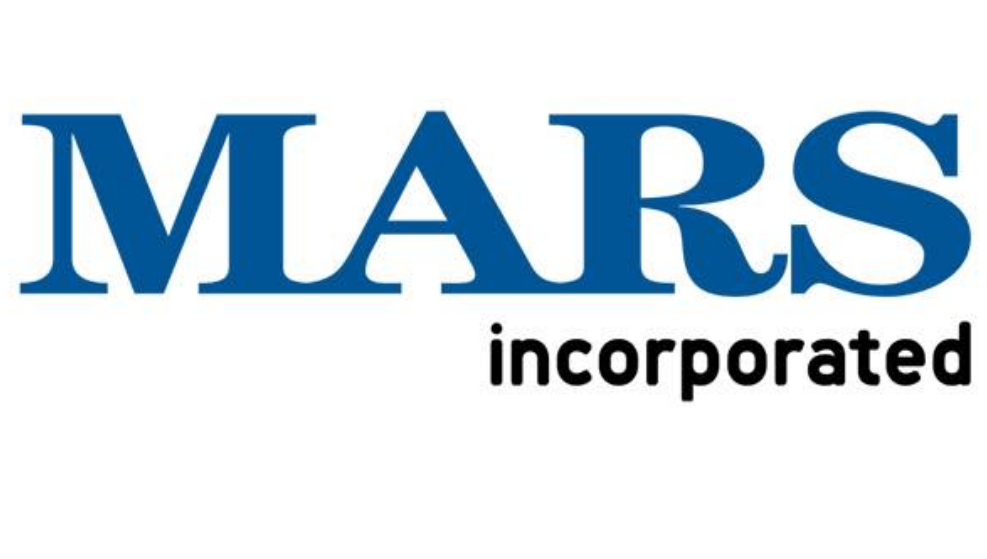
You can say that it's how things are done in a company that is entirely controlled by the family.
Fortune's study indicates that employee turnover in the United States is just about 5%, and Mars can point to families that have employed successive generations.
Mars is aware that it must acquire this kind of devotion in order to motivate it.
The five Mars principles—quality, responsibility, mutuality, efficiency, and freedom—are written on every wall of every Mars office and manufacturing facility around the world, which is spread across 73 nations. They are a cult as much as a culture, according to an employee named Will Turnipseed who spoke to Fortune, although "they don't tattoo them on us or anything like that."
In addition, Mars is a serious company. Consider the concept of "quality." Approximately 2% of all M&Ms production is discarded due to "blemishes" or other quality issues.
Key Takeaways
- Establish a set of agreed values and encourage them at work.
- Make sure your group and business fulfill the value that was promised.
- Daily expressions of gratitude will help you keep staff for many years to come.
Hyatt: Long-term training is provided to its employees
An individual working in housekeeping often remains with Hyatt for more than 12 years.
Over 14,000 of Hyatt's roughly 75,000 US workers have been with the company for more than ten years in total.
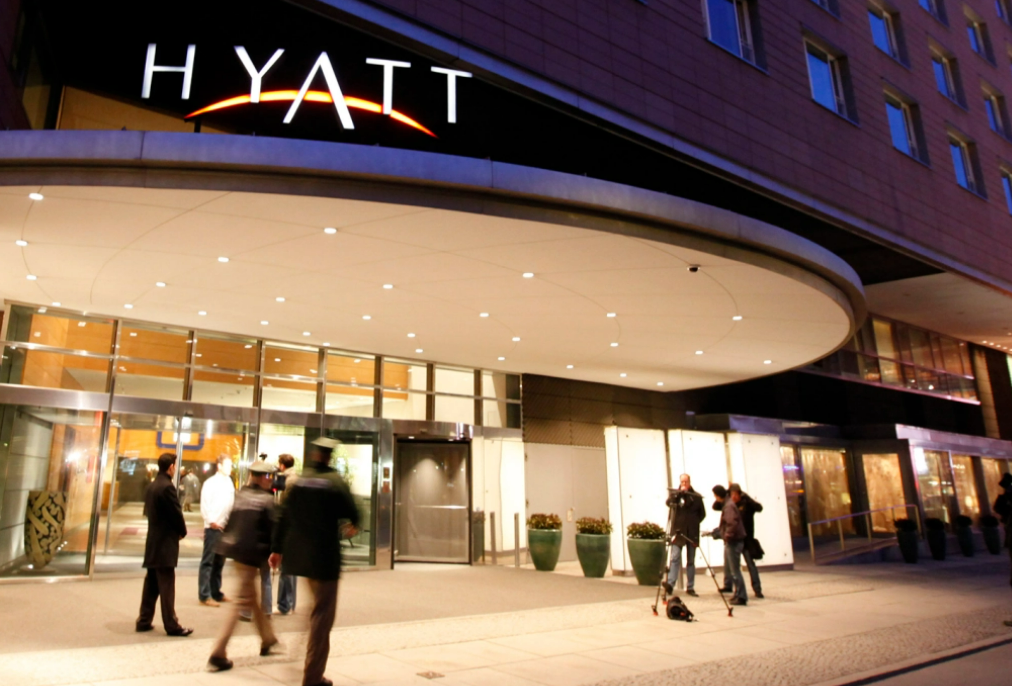
The hotel chain is obviously taking steps to retain its personnel.
The Hyatt training program is excellent, and the business has a strong approach to hiring internally by recognizing prospective leaders among its current personnel.
The business recently released "Change the Conversation," a completely revamped training curriculum that emphasizes listening and is based on concepts from the Stanford School of Design.
Employees are urged to come up with fresh, original solutions for issues and carry out daily activities. It places such a high value on employee loyalty that the Employee Referral Program serves as its primary source of new recruitment.
Hyatt has also promoted diversity in the workplace.
The AARP praised Hyatt for its commitment to hiring older Americans, and the NAACP and Hispanic Business magazine both highlighted Hyatt for its hiring of African American and Hispanic employees, respectively. Hyatt has also made the Human Rights Campaign's Best Place to Work for LGBT Equality list for ten years running.
Key Takeaways
- Investing money into top-notch education and training initiatives will retain staff with your business for longer.
- Encourage workplace diversity.
- Encourage your employees to use creativity to solve challenges on their own.
How Deskera Can Assist You?
Deskera People has the tools to help you manage your payroll, leaves, employee onboarding process, and managing employee expenses, all in a single system. Features like a flexible payment schedule, custom payroll components, detailed reports, customizable pay slips, scanning, uploading expenses, and creating new leave types make your work simple.

Final Takeaways
We've arrived at the last section of this comprehensive guide. Let's take a look at the following points that you must remember for future reference. Let's learn:
- Employee retention refers to a company's capacity to maintain (retain) its current workforce over a prolonged period of time. It is directly related to employee experience because increased Intent to Stay is linked to positive experiences.
- Employer retention strategies, which are frequently employed to boost employee engagement and provide attractive incentives, can help organizations avoid having excessive amount of turnover.
- Keep in mind that employees stay with your organization longer if your retention rate is higher. Your retention rate will decrease the more often you hire and fire people for the same position.
- Without the right talent, your company won't be able to grow or achieve its objectives. If the right staff aren't already present, your company won't be able to hire the extra workers it will need.
- Being in a workplace where you constantly worry about getting fired is incredibly unsettling. And while employing fresh talent might be thrilling, it can also leave you with the impression that you don't know anyone at all.
- By routinely monitoring the employee retention rate, an organization may keep track of its workforce, establish whether employee counts are going up or down, and spot any barriers to employee growth. Using this information, a company can enhance its onboarding procedures and staff retention strategy.
- It is crucial that managers have the tools and support they need to not only hear what their employees have to say but also to act on it in order to improve their experiences and increase employee satisfaction. Nearly all of the major factors that affect employee engagement are influenced by managers.
- Eventually, your company's culture, productivity, and competitiveness are all influenced by how well you can keep your staff.
- Without the right talent, your company won't be able to grow or achieve its objectives. If the right staff aren't already present, your company won't be able to hire the extra workers it will need.
- Do some research to determine the competitive pay scale for your staff (and, if required, hire a consultant). Make remuneration trustworthy and fair. Make sure employees are informed of every detail of their salary.
- Retention and employee experience are closely tied. In fact, one of the five KPIs we take into account when assessing the quality of employee experience a company offers is Intent to Stay.
- Organizational effectiveness is increased by talent retention. When a high-performing employee leaves, replacing them can be difficult and time-consuming due to the continuous screening processes of interviews, onboarding, and onboarding programs.
- Supervisors can welcome new team members, offer guidance, and act as a source of advice. And it benefits both parties because new team members get knowledge from seasoned workers while also providing their mentors with a different perspective.
- Prioritizing training and development is crucial, as is seeing it as part of corporate culture as opposed to just being the duty of a human resource. There are situations when sending a worker to a course won't yield the desired results. Consider development as a natural component of life instead.
Related Articles

